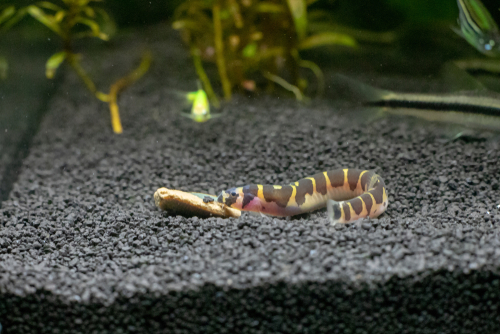With a sinuous white or pink body marked by black, brown, gray, yellow, or silver bands, the Southeast Asian Kuhli Loach fish is an interesting and beneficial addition to any community tank. A peaceful bottom feeder, this fish will clean up the substrate without uprooting any aquarium plants. Their mellow temperament enables them to get along with many other non-aggressive fish species that are similar in size.
Some of the best Kuhli Loach tank mates include various kinds of guppy, gourami, bettas, tetras, danios, and even unusual choices like a Black Molly or Cherry Shrimp. Choose fish that inhabit different parts of the aquarium, from the substrate to the middle tank and the upper water column to avoid confrontations from food and space competition.
Discover the best tank companions to house with your Kuhli Loach.
Contents
The Best Kuhli Loach Tank Mates
1. Neon Tetra
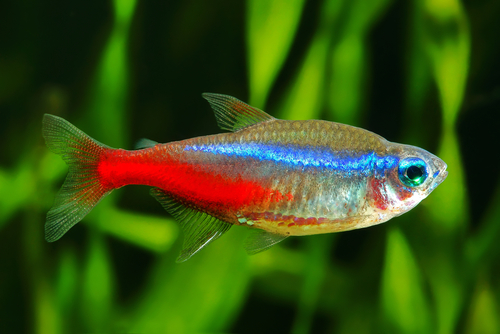
- Scientific name: Paracheirodon innesi
- Origin: Amazon River Basin
- Size: 1 and 1/2″ long.
- Care level: Beginner
These beautiful fish stand out for their silvery blue upper scales and flame-colored lower bodies. With their gentle natures, Neon Tetras make perfect tank mates for mellow the Kuhli Loach.
They also spend most of their time swimming in the middle tank, so they won’t bother Kuhli Loaches who prefer to graze along the bottom. Neon Tetras have specific water parameters, so it’s important to ensure that these are met to avoid vulnerability to specific tropical fish diseases. Neon Tetras consume an omnivorous diet of algae, crustaceans, and frozen food.
Pros for keeping with Kuhli Loach
- Non-aggressive and beginner-friendly
Cons for keeping with Kuhli Loach
- None
2. Betta Fish
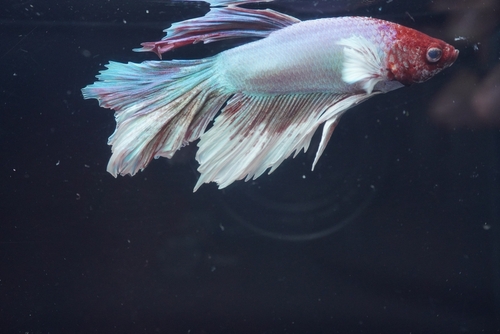
- Scientific name: Betta splendens
- Origin: Thailand, Indonesia, Malaysia, Laos, Cambodia, and Vietnam
- Size: Up to 3 inches
- Care level: Challenging
With their feisty temperaments and bottom-feeding habits, Betta fish might not seem like a natural mate for their Kuhli Loach neighbors. Also known as Japanese Fighting Fish, they don’t usually bother Kuhli Loaches.
That’s because these two species spend most of their time hiding in between looking for food. Since Loaches have less bright tones and no long fins, Bettas don’t have anything to nip at and generally overlook them.
These fish enjoy fresh and frozen brine shrimp, bloodworms, and sinking pellets.
Pros for keeping with Kuhli Loach
- Low maintenance and setup costs.
Cons for keeping with Kuhli Loach
- Aggressive
3. Pearl Gourami
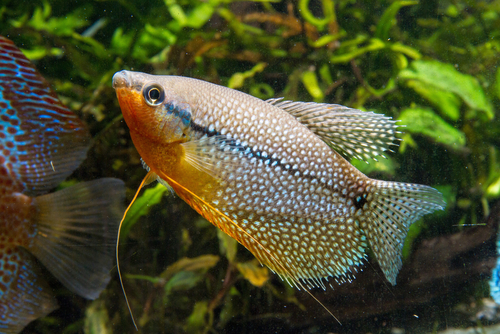
- Scientific name: Trichopodus leerii
- Origin: Indonesia, Malaysia, and Thailand
- Size: Up to 5″ long
- Care level: Beginner
If you want a middle swimmer fish that will stay out of your Kuhli Loach’s way, look no further than the Pearl Gourami. Since they inhabit completely different spaces in the tank, they won’t interact much at all.
Since Pearl Gouramis are super easygoing, they get along well even with smaller fish such as tetras and guppies. Like many species, it’s always best to keep just one male with the females since multiple males from the same species tend to get territorial and fight each other.
This omnivorous fish eats algae, blackworms, glass worms, brine shrimp, and veggies such as spinach, cooked peas, and lettuce.
Pros for keeping with Kuhli Loach
- Mellow and easy for beginners.
Cons for keeping with Kuhli Loach
- Prone to bacterial infections such as fin rot.
4. Clown Loach
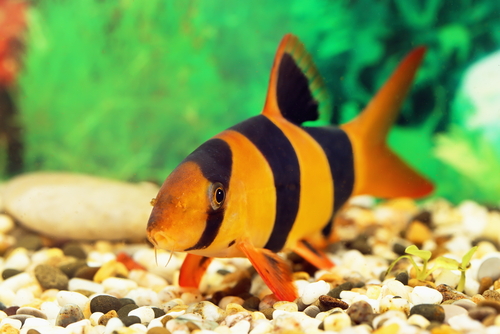
- Scientific name: Chromobotia macracanthus
- Origin: Sumatra and Borneo
- Size: 6 to 8 inches
- Care level: Expert
Just like the Kuhli Loach, the Crown Loach is a docile fish. As a schooling species, Crown Loaches spend most of their time swimming between the middle and bottom of a tank. They have more distinct fins atop their yellow body marked with black bands and tipped with orange-colored fins.
These fish consume fruits such as bananas, flakes, and live food such as bloodworms.
Pros for keeping with Kuhli Loach
- Peaceful temperament
Cons for keeping with Kuhli Loach
- Requires a spacious tank
5. Fancy Guppy
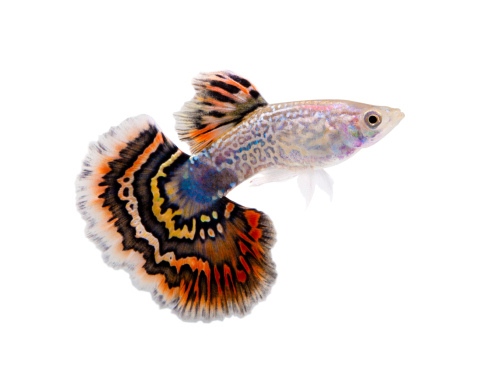
- Scientific name: Poecilia reticulata
- Origin: Brazil, Guyana, Trinidad, the Amazon River, Tobago, and Venezuela
- Size: May reach 2.5 inches
- Care level: Beginner
These gentle little multicolored fish are great tank companions for your Kuhli Loach. Their long fins give them their fancy name. Not only are they affordable and available at many pet stores, but they make great starter fish.
These fish enjoy a live plant aquarium that offers plenty of hiding places. They also eat bloodworms, brine shrimp, tubifex worms, and premade guppy food. Just make sure that you do a proper nitrogen cycle in the tank before adding any guppies to ensure that their environment is safe.
Pros for keeping with Kuhli Loach
- Peaceful temperament and easy for beginners
Cons for keeping with Kuhli Loach
- None
6. Harlequin Rasboras
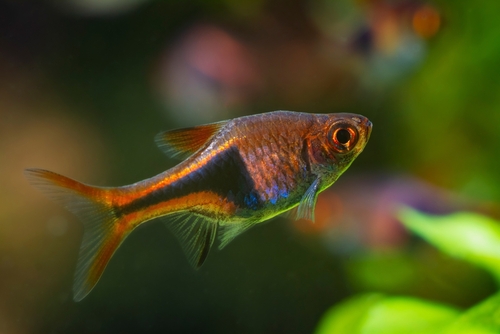
- Scientific name: Rasbora heteromorpha
- Origin: Malaysia, Singapore, Sumatra, and southern Thailand
- Size: May grow 2″ long
- Care level: Beginner
A peaceful omnivore with striking color patterns, the Harlequin Rasboras is an easy tank mate. It’s also a schooling fish that can enjoy a long life under proper environmental conditions.
These fish are a breeze to keep because they will eat practically any food that you’re feeding your other fish. This includes frozen and live meats, flakes, and pellets.
Pros for keeping with Kuhli Loach
- Adaptable and peaceful
Cons for keeping with Kuhli Loach
- Their small size may make them vulnerable to larger, predatory fish
7. Dwarf Gourami
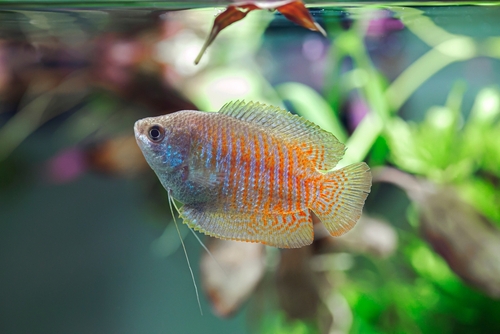
- Scientific name: Trichogaster Ialius
- Origin: Bangladesh, India, and Pakistan
- Size: 3.5 inches
- Care level: Intermediate
These bright and iridescent speckled blue and red fish get along swimmingly with both middle dwellers and bottom feeders. They hold their own if their fellow fish aren’t too large and coexist best with small schooling species.
This shy fish typically won’t get territorial unless a similarly bright-colored male enters its space, and the Dwarf Gourami thinks that it’s a rival. Like many compatible species, this fish loves lots of cover and hiding spaces. It will eat many live and frozen food and veggie pellets.
Pros for keeping with Kuhli Loach
- Non-aggressive and good for beginners
Cons for keeping with Kuhli Loach
- Produce a lot of waste
8. Discus
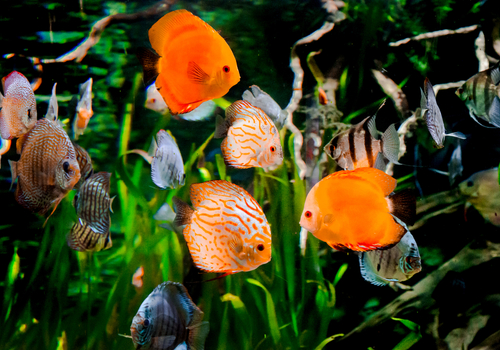
- Scientific name: Symphysodon
- Origin: Amazon River
- Size: Up to 9 inches
- Care level: Challenging
This fun and beautiful fish is a rounded species that come in a variety of red, blue, and yellow shades. They do best in groups of 4 to 5 other Discus fish, since they can get overwhelmed if alone.
The Discus is recommended for expert aquarists since it is a high-maintenance fish. They demand a special diet that is high in protein and essential fatty acids, while they need stable, tropical-temperature water that is often higher than advised for other species. They also need water pH that falls into the soft or moderately hard range since Discus are super sensitive to shifting water parameters.
Pros for keeping with Kuhli Loach
- Non-aggressive
Cons for keeping with Kuhli Loach
- Need a 75-gallon or larger tank. Highly specialized food and water chemistry levels.
9. Cardinal Tetra
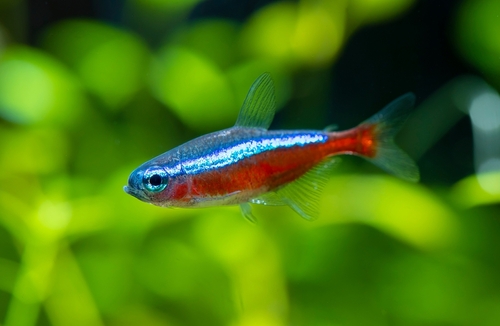
- Scientific name: Paracheirodon axelrodi
- Origin: Amazon River
- Size: 1.25 inches
- Care level: Easy
Like the Neon Tetra, the Cardinal Tetra is a peaceful little fish with extra-bright colors that makes an excellent tank mate. Since they are schooling fish, they will demonstrate more interesting behavior when in a group. If you only have one or two Cardinal Tetras, they tend to act fearful and hide.
You can use a UV light to watch them glow in the aquarium like little rainbow lights. They also appreciate live or frozen foods in addition to food flakes.
Pros for keeping with Kuhli Loach
- Non- aggressive and adaptive
Cons for keeping with Kuhli Loach
- May be seen as prey by larger fish
10. Cory Catfish
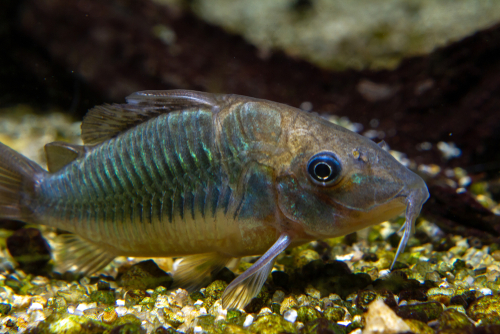
- Scientific name: Brochis splendens
- Origin: Central South America
- Size: 2 and 1/2″
- Care level: Easy
A bottom-feeding scavenger, the Cory Catfish doesn’t have a problem getting along with its fellow bottom-dweller, the Kuhli Loach. As schooling fish, they are great at cleaning up algae and stray bits of food from the tank.
Even better, these omnivorous fish aren’t picky eaters and will eat just about any kind of food that you throw into the tank.
Pros for keeping with Kuhli Loach
- Robust, non-aggressive, and adaptable
Cons for keeping with Kuhli Loach
- Hard to tell if bottom feeders are getting enough nutrition
11. Zebra Danios
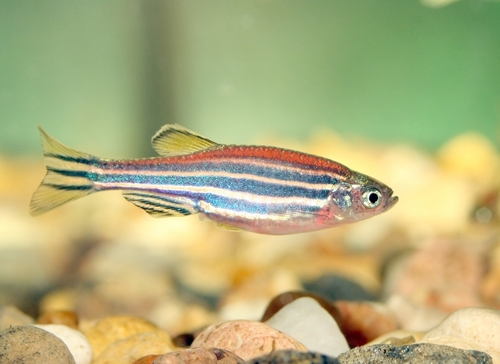
- Scientific name: Brachydanios rerio
- Origin: South Asia
- Size: 1.5 inches
- Care level: Easy
Despite its name, the Zebra Danio has horizontal rather than vertical stripes, but the name refers to its black and white-striped coloration. These schooling fish are active swimmers who prefer to navigate the middle tank in a school formation.
They aren’t fussy eaters and consume a variety of worms and algae. They are also space-economical since you can keep up to 5 of them in a 5-gallon tank. Just make sure to get an appropriately larger tank if you have more fish or species.
Pros for keeping with Kuhli Loach
- Non-aggressive and friendly schooling fish
Cons for keeping with Kuhli Loach
- May occasionally nip other species with long fins
12. Black Molly
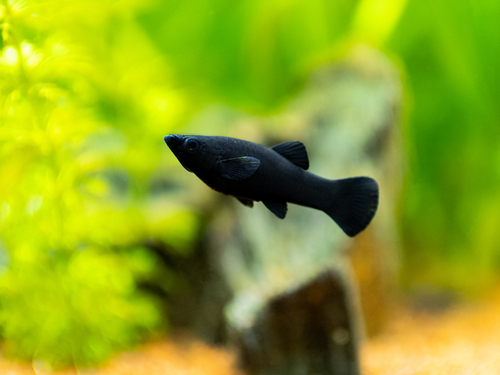
- Scientific name: Poecilia sphenops
- Origin: Mexico, Columbia, and Central America
- Size: 3 inches
- Care level: Easy
These black beauties are also live-bearing fish that get along well with Kuhli Loach in a mixed tank. They also come in a variety of dramatic shades, patterns, and colors which can add activity and interest to your aquarium.
If your Black Mollys produce, just make sure to take the fry out or their parents and larger fish will end up eating them.
They are active and enjoy a wide variety of frozen, fresh, and pellet food.
Pros for keeping with Kuhli Loach
- Cleans green and brown algae from the tank
Cons for keeping with Kuhli Loach
- May become aggressive in an overcrowded or hostile tank
13. Cherry Shrimp
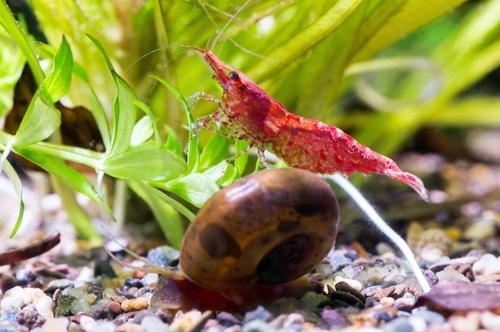
- Scientific name: Neocaridia davidi
- Origin: Taiwan
- Size: Up to 1.25″
- Care level: Moderate
Add some fiery color with the Cherry Shrimp. Not only will they not bother your Kuhli Loaches, but they are also peaceful creatures who do an excellent job cleaning up the tank.
These aquatic creatures are useful and omnivorous companions that consume algae and leaf litter without damaging any aquarium plants.
Pros for keeping with Kuhli Loach
- Keeps the tank clean and doesn’t need specialized water parameters.
Cons for keeping with Kuhli Loach
- May fail to molt due to nutritional deficiencies.
14. Angelfish
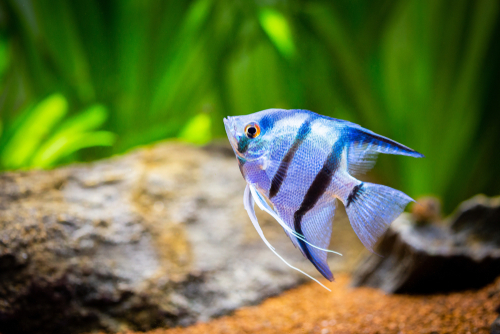
- Scientific name: Pterophyllum
- Origin: South America
- Size: 4 inches long and 6 inches tall
- Care level: Easy
Shaped like angels, these fish have tall and fancy fins. With different colors and typically gentle personalities, they are great companions for the non-aggressive Kuhli Loach fish.
These fish tend to get territorial with their own kind during mating periods and may demonstrate seasonal semi-aggressive tendencies. They also appreciate a quiet environment since loud noises can make them jumpy. While they might feed on smaller fish in the tank, they usually consume meaty live and frozen foods.
Pros for keeping with Kuhli Loach
- Not a picky fish that can handle higher water temperatures than other fish
Cons for keeping with Kuhli Loach
- Can get nervous in the company of other species
15. Apistogramma
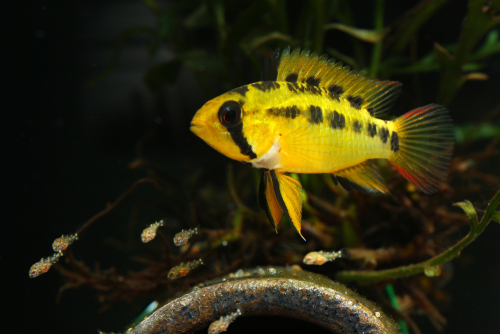
- Scientific name: Apistogramma cacatuoides
- Origin: South America
- Size: 0.8 inches
- Care level: Easy
Also known as the Cockatoo Dwarf Cichlid, this adorable fish has a shimmering gold, blue, red, yellow, or orange body. Due to their tiny size and delicate fins, it’s best to keep them with gentle fish that don’t nip. They are peaceful companions and a perfect choice for a community tank.
They have curious personalities and love to explore their environment. They thrive in schools of fish and enjoy a variety of glass worms, other worms, and baby brine shrimp.
Pros for keeping with Kuhli Loach
- Easy, fun, active, and peaceful
Cons for keeping with Kuhli Loach
- Tiny size could make them vulnerable to bigger fish
Final Thoughts
Kuhli Loach’s easy going personality makes it simple to get along with many tank mates. Just make sure to have a large enough tank to accommodate all your different fish. It’s best to choose mates that are similar in size to discourage the larger fish from preying on the smaller ones. In general, schooling fish demonstrate calmer, more interesting behavior if you create a small school.
Most of the fish on this list require simple care, which makes them good options for both newbies and experienced aquarists. Check each fish’s specific water temperature, cleanliness, and pH requirements prior to purchase. It’s also a good idea to use sinking pellets to ensure that bottom feeders get the nutrition that they need
This will help ensure that you have a proper filtration system and can provide consistent water parameters. While some fish adapt easily to small changes in water requirements, others are extra-sensitive to different degrees or salinity levels. With a little work, it’s possible to ensure a comfortable environment for everyone in your community tank.
Check out these other related posts:

Ian Sterling, founder of Fishlab.com, began his aquarium journey over 30 years ago, driven by a deep fascination for fish and their diverse personalities. His website, Fishlab.com, is dedicated to making fishkeeping accessible and enjoyable, offering beginner-friendly guidance, expert insights, and a community for aquarists to connect and share experiences.


